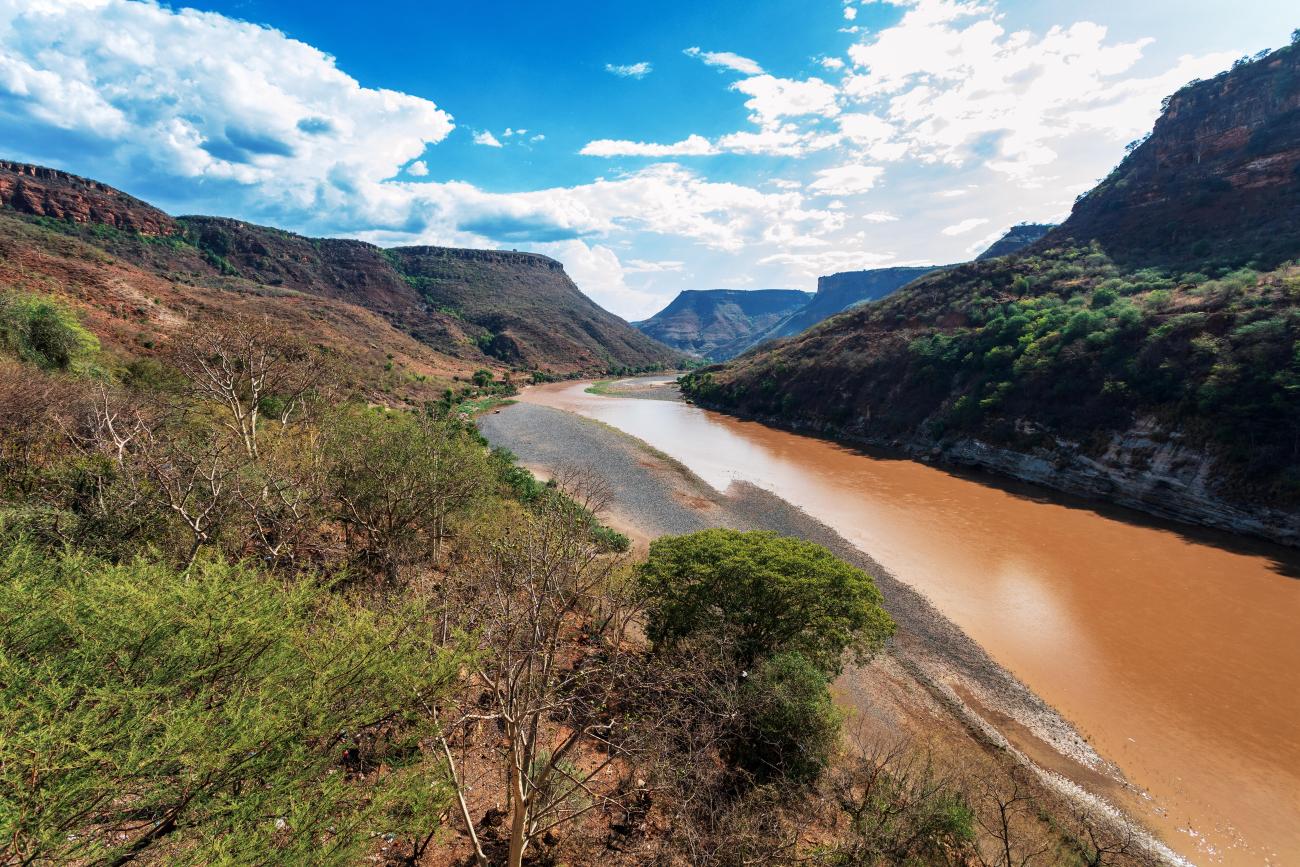Scientists at the Environmental Change Institute have developed a model to evaluate the impacts of new dam construction in the Eastern Nile Basin.
Researchers from the Oxford Programme for Sustainable Infrastructure Systems, (OPSIS) at the Environmental Change Institute (ECI)are among a team evaluating the implications of constructing two new hydropower dams in Ethiopia along the Blue Nile and how this may interact with further irrigation projects for agriculture.
Their study: 'The implications of further reservoir development on the Blue Nile in Ethiopia: trade-offs between hydropower, irrigation and transboundary water security', has been published in the journal Environmental Research Letters. The researchers use the Eastern Nile RiverWare Model to examine the consequences for Ethiopia, Sudan and Egypt of further development of hydropower and irrigation on the Blue Nile in Ethiopia. Their analysis quantifies changes in annual hydropower generation, rates of reservoir evaporation, and impacts of these potential developments on the management of Egypt’s downstream High Aswan Dam (HAD).

Blue Nile in Amhara Region, Ethiopia
Co-author Prof Jim Hall, OPSIS programme lead at the ECI said:
If both irrigation and hydropower generation occur throughout a river system, these trade-offs can be complex. By withdrawing water for irrigation upstream, less water is released for hydropower facilities downstream.”
Working alongside Prof Jim Hall were Dr Kevin Wheeler, an Honorary Research Associate at the ECI, Dr Anna Murgatroyd, a former Postdoc Research Associate at the ECI now Lecturer in Hydrology at Newcastle University, and Prof Dale Whittington from the University of North Carolina at Chapel Hill and also Emeritus Professor at the University of
Manchester.
Study Background
The Nile Basin has been embroiled in controversy over the Grand Ethiopian Renaissance Dam (GERD) since the late Ethiopian Prime Minister Meles Zenawi announced in 2011 that Ethiopia would build the largest hydroelectric power dam in Africa on the Blue Nile immediately upstream of the Ethiopia-Sudan border.
Construction of the GERD has stimulated considerable disagreement among the neighbouring countries, as development and operation of the dam will change downstream flow patterns significantly and has the potential to affect water availability in Sudan and Egypt. In July this year, the GERD was reported to be over 90% complete with the reservoir holding 42.5 bcm (billion cubic metres), (109m3) of water.
As divisive as the construction and filling of the GERD has been, the authors highlight another controversy that looms over the management of Nile. For decades Ethiopia has sought to build a cascade of dams along the Ethiopian Blue Nile, with the GERD being the terminal dam before entering Sudan. Ethiopia also has plans to utilise additional water from the Blue Nile for irrigation. These two development objectives compete for the same water resources in Ethiopia, and how Ethiopia resolves this trade-off will have implications for downstream countries.
Research objectives and results
This paper has three objectives:
- To quantify how large dams upstream of the GERD would change hydropower production and reservoir evaporation losses in both Ethiopia and downstream.
- To calculate how additional irrigation withdrawals in Ethiopia would affect the probability of the HAD falling below a storage volume of 60 bcm, which would invoke their current drought management policy that reduces annual releases below 55.5 bcm.
- To characterise the financial trade-off between using water for future irrigation in Ethiopia, compared to using water to generate hydropower throughout the Nile system and then for irrigation downstream in Egypt.
Large transboundary river systems offer opportunities for hydropower generation, irrigation and other purposes. Where water resources and topography permit, as they do on the Blue Nile in Ethiopia, there can be large financial rewards from hydropower generation. However, robust planning techniques are needed to understand the trade-offs between hydropower and other purposes.
The analysis indicates that two new dams upstream of the GERD could increase average annual hydropower on the Blue and Main Nile by almost 50%, from 30.2 TWh (terawatt hour) a year to 44.7 TWh a year. However, the analysis demonstrates how development of irrigation schemes upstream of the GERD and a Blue Nile cascade will reduce the financial benefits of hydropower generation from this infrastructure. Irrigation withdrawals of 5 bcm a year upstream of a three-dam cascade result in reduction in hydropower across the Blue and Main Nile River of 6.8 TWh a year (15.2%).
Research reflections
The authors highlight the complexity of development by stating:
In all transboundary rivers, the future values of hydropower and irrigation water supply are uncertain. They will depend on technological change, climate change, government policies, geopolitical developments, and other factors that cannot be predicted.”
The paper argues that, in the face of this uncertainty, a robust planning approach is needed to identify an investment strategy that facilitates the best decisions possible.
Furthermore, the authors argue that managing water security for people in the Nile basin and the development of additional infrastructure and irrigation schemes requires strong, binding, and adaptive international agreements.
The paper concludes by stating: “The modelling approach described in this paper can assist riparian countries to plan cooperatively for the future development of transboundary water resources. Analyses such as presented in this paper on water energy and food trade-offs can assist riparians develop plans for future development that will provide a balanced, equitable sharing of basin-wide benefits.”
Read the paper in full: The implications of further reservoir development on the Blue Nile in Ethiopia: trade-offs between hydropower, irrigation and transboundary water security


